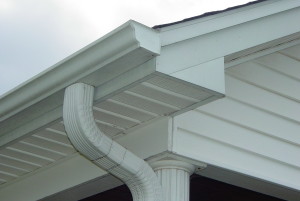As an integral part of your gutter system, downspouts need to be situated carefully for maximum effectiveness. Most often, homeowners buy a house and never think about the gutter system and how it functions until something breaks – then the cost to replace can be expensive when the price of education and inspections is significantly more affordable.
Maintaining the integrity of your home’s roof includes various factors: shingle health, structure support strength, gutter placement and efficiency, and more. There are some standard practices to follow when looking at the baseline quality of your gutters. While each home is different, there are a few basics all roofers follow.
It can be hard to know exactly how many you need and the optimal spots to place them, but as a general rule of thumb, your gutters should have one downspout every 30-40 feet. There are, however, exceptions to this rule.
Factors That Influence Downspout Placement
-
- A steep roof. The greater the slope of your roof, the more quickly water is going to move off of it, which means your gutters are going to encounter a higher volume of water in a shorter period of time than roofs that are more gently sloped. Between Cincinnati’s crazy weather and unpredictable swings in the seasons, you can see stretches of dry weather then suddenly inches of rain the next. High volumes of water can come quickly, and if the gutters aren’t set up correctly or clogged, you can quickly identify weaknesses and issues. Take a look at your gutters the next time there is a rainstorm. If it seems like they’re have a hard time handling that amount of water, consider putting up an additional downspout to help with the problem.
-
-
- Increased roof surface. Bigger houses mean bigger roofs and more surface area for rainwater to drain off. With greater amounts of water running down the roof and into the gutters, the number and location of the downspouts will need to be adjusted to prevent gutters from overflowing. Think of it as a bath tub: a larger tub holds more water, has a larger drain, and higher sides. It is built to support more water and more volume – a larger roof will need supported by additional downspouts to alleviate stress on the ones installed.
- Gutter size. The size of your gutters will greatly affect how many downspouts you need. Large gutters that can handle a greater volume of water can get away with a smaller number of downspouts, while smaller sized gutters will need the extra help from additional downspouts. If you think your home could use more downspouts, but you don’t want to mess with installing new ones, sometimes it’s possible to switch out existing spouts for ones that are larger in diameter and will allow faster drainage. Just make sure to measure your gutters to ensure they’re large enough to accommodate bigger downspouts.
-
If you’re having issues with overflowing gutters or just aren’t sure if your gutter system is adequate for your needs, give Titan a call! Cincinnati’s expert gutter and roofing specialists, we are happy to discuss options and choices for updating your home’s gutter system.






